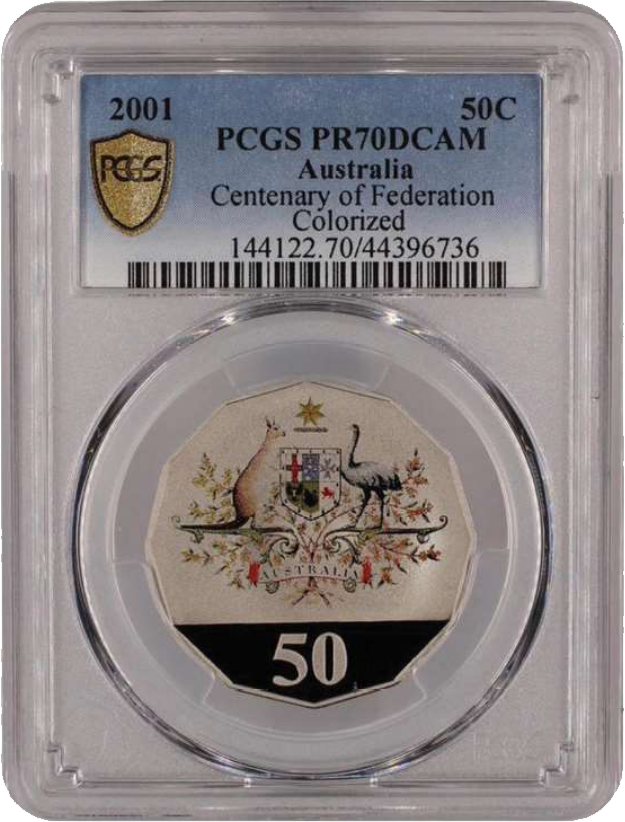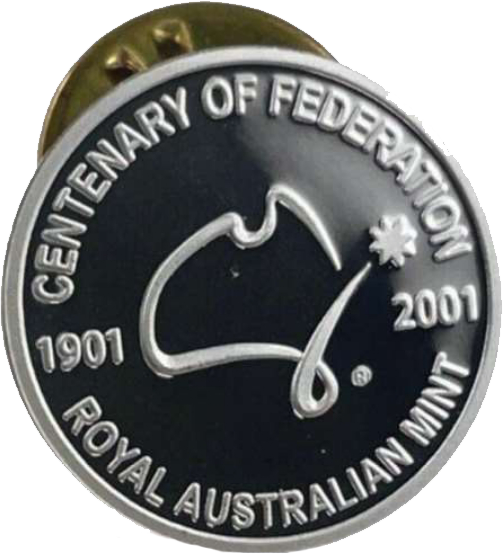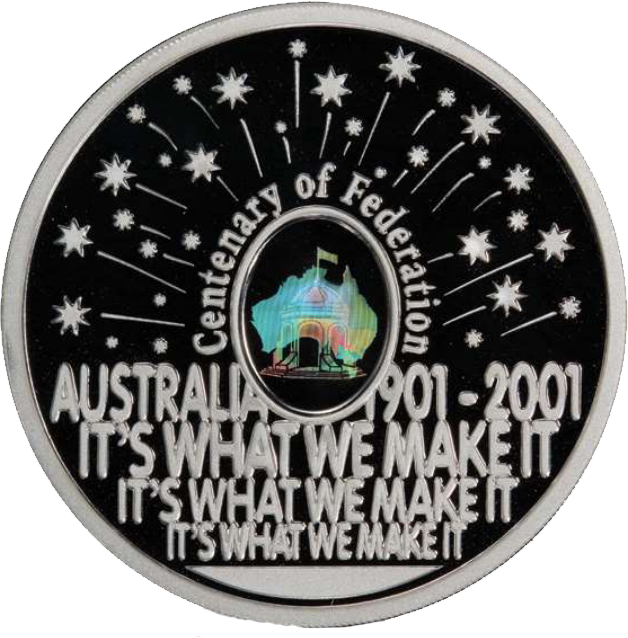
Following recent record prices achieved for Centenary of Federation coins, this month’s Minted will be reviewing the Royal Australian Mint’s hefty 2001 Centenary celebration1s coin program.

The Centenary of Australia’s Federation was celebrated in 2001, one hundred years after the six separate colonies of New South Wales, Victoria, Queensland, South Australia and Western Australia united to form the Commonwealth of Australia. The 1901 Federation was the culmination of decades of lobbying and debating, as well as rounds of state-wide referendums. The centenary of this momentous occasion was celebrated by the Royal Australian Mint (“the Mint”) with a series of commemorative coins and medallions. The Mint’s Centenary of Federation Coin Program was recognised as one of the ‘best ways to remember this milestone year in Australia’s history’1 With the huge volume of numismatics products released by the Mint for the Centenary of Federation only outdone by the global event of the Sydney Olympics held the year prior, the Mint’s Federation products were ubiquitous; from the classrooms of primary school children, to the coins used in day-to-day cash transactions. With collector interest in commemorative decimal coins never being stronger than it is now, the Federation Centenary coins are beginning to gain traction as collectors look to fill those gaps in their collections.

Commonwealth of Australia Gazette 1st Jan 1901 Proclamation from Queen Victoria passing the Act of Federation published by the Governor-General’s Office, Sydney. Image courtesy of Roxbury’s Auction House, Auction No. 110, Lot 182
The first Federation Centenary mint product I ever had was the Federation Centenary Medallion, given to all primary school students in Australia. As a 6 year old, I can’t say that I fully appreciated the free gift from the Mint, nor do I know where my medallion ended up. But with over 2 million produced, these base metal commemorative medallions are readily found on the stock shelves in all coin shops and are not a scarce product.

Gifted by the Mint in May 2001, this medallion’s reverse was designed by school teacher John Skillington from Albury, NSW Image courtesy of www.numista.com
However, many other Federation Centenary products are scarce, and are highly sought-after by modern coin collectors. The twenty-coin proof set has been steadily rising in interest and price, and the standard issue proof set with the coloured S0c and one dollar coins is selling for more than double its original issue price.
The most accessible Centenary of Federation coins are the circulation-issued 20c and 50c coins. Featuring each state and territory’s coat of arms and floral/faunal emblems, these commemorative coins all had mintages in excess of 2 million. While the 50c coins featured each state’s official coat of arms, the 20c coins had competition-winning designs proposed by school children around the country.
Preparing for this article, I spoke with Dr. Abbey MacDonald from Launceston TAS, who designed the Tasmania 20c coin. Abbey remembers entering the competition in late 2000, along with several other students from her school. She was in Year 11 at the time, and her iconic drawing of the Tasmanian Tiger at the foreground of the coin’s design was selected from over 300 entries.
Abbey is now a Senior Lecturer in Arts Education at the University of Tasmania, and continues to be involved in creative arts and education. When the Mint held the competition for coin designs back in 2000, Abbey was in boarding school, and spent many hours working on various sketches and drawings, for one to ultimately be minted on millions of coins. A minor incident of noodle soup being spilt on the final design did not hinder its outcome, and the coin we see in circulation today is the final result of Abbey’s artistic skills as a schoolkids.
ACR: The Royal Australian Mint opened the competition in 2000 in preparation for the centenary event. Was your whole class at the boarding school involved in making up designs?
Abbey: At the time of this competition, I was in grade 11 at Launceston Church Grammar School, where I was taught by an incredible team of art teachers. Paul Snell and Katy Woodroffe were, and continue to be, integral teachers in my life. I remember vividly them encouraging me and my peers to create something for the Centenary of Federation coin design. Knowing them, they’d have encouraged kids in other classes to have a go as well. They were good like that; always encouraging us to push and extend ourselves, and to try new things. They were prepared to chase me up and challenge me, which I needed and benefited hugely from.
ACR: What is the story behind your design?
Abbey: As is my way, I tend to be my most creative under pressure – I remember the design coming together quickly and messily. I spilt two minutes noodles (chicken flavour I believe) on it at one point, which I had to quickly mop up and dry out. I recall having worn the entry paper down quite thin in places where I had drawn, rubbed out and redrawn aspects of the design until I was happy with it. The pose and gaze of the tiger was something I was keen to capture; something that looked equal part scary, worried and beautiful. This is how I felt about the Tasmanian tiger; it’s enigmatic. I still feel these things when I look at the coin.
ACR: Were you expecting to win? Do you remember how you found out that you won?
Abbey: It was a genuine shock and surprise to learn that my design had been selected as the winner. I cannot stress enough how such experiences of recognition can shape a person’s personal and professional trajectory. There are of course many other art competitions I’ve put myself out there for and haven’t won. Each experience has been humbling and affirming for building my tenacity, ambitions and passions. For me, winning this competition was hugely affirming as a 16/17 year old kid wondering what to do next. It was hugely impactful upon the choices I made and advocating for myself to be brave and trust in pursuing a career in the creative arts and arts education. I’m deeply invested in and committed to enabling opportunities for teachers to champion and students to put themselves out there to pursue art competitions. I remember Paul and Katy taking me out to lunch to celebrate this achievement, and they bought me some beautiful oil sticks (my favourite medium at the time), art paper and art books. They have, and continue to be so encouraging of me. I even did my art teacher training with them, and ended up working alongside them in the art department where I was taught, and where I worked on this coin design! Teachers are so important and can have such a legacy and lasting impact on our lives. I remember too that this particular prize was incredibly generous; I think my school secured $5,000, and I believe this was used to kick start the media arts department at my school, which was starting to build momentum.

The Opening of the First Parliament of the Commonwealth of Australia by H.R.H.The Duke of Cornwall and York (later King George VJ. on May 9. 1901. Painting by Tom Roberts. Image courtesy of the National Museum of Australia.
–End of Interview–
The Tasmanian 20c coin design also went global in 2002, when it was nominated as ‘Coin of the Year’ by the worldwide Krause Publications-led competition in the circulating coins category2. A huge achievement for the coin, up against hundreds of circulating coin designs from all over the world, and one of four coins produced by the Royal Australian Mint that year to have received nominations. The eventual winner of the 2001 circulating coin category was the USA Rhode Island clad 25c coin from its iconic State Quarters series. A further testament to the success of the Mint’s Centenary of Federation Coin program, the circulation 20c and 50c coins have remained popular. Several of the states/territories attract premiums due to their scarcity. In uncirculated condition, a full set of the Federation 20c coins typically sells for $50+, whilst the uncirculated set of ten 50c coins fetches $70+.
The Mint’s 2001 proof set is also a popular memorabile of the Federation anniversary, with the coloured coins from the set continually increasing in value. Found in the standard six-coin proof set as well as the premium twenty-coin proof set, the 50c coin with the colourised coat of arms design has seen sales topping $400+ for PR 70DCAM PCGS graded examples, and the coloured one dollar coin with its red and blue motif is scarcely seen on the market graded by PCGS, with a small population of just 46 coins achieving the PR 70DCAM perfect grade. Anomalously, the proof one dollar coin alone sells for the same price as the entire standard six coin proof set, if not more than the complete set; $150+ when raw, and double that when slabbed and graded by PCGS.
As for the non-coloured also included a range of precious metals products – the proof states and territories commemoratives, the PR 70’s achieve sound sales results but are still generally underrated, representing great value for the astute collector pursuing top pop coins. The student-designed proof 20c coins sell for anywhere between $70-$150 for a perfect PR 70DCAM, and the proof 50c coins average out at around $150 each in the top tier PR 70DCAM grade. As 50c coins are one of the most-collected decimal denominations, these prices are an attractive buy, with many of the states and territories in the proof Federation 50c coins series having less than 40 coins sharing the top PR 70DCAM spot.
In the Centenary of Federation Mint State highlights, the uncirculated one dollar coin achieves the strongest results in terms of price – but not for grade. The MS 68 pictured is the top graded coin, with only 28 other coins achieving this grade, and zero scoring higher. The other uncirculated coins from the series don’t fare much better – out of the twenty commemorative 20c and 50c coins, none have graded at an MS 70. For the 20c coins, only 8 out of 600 coins submitted to PCGS have scored MS 69 – a tiny 1.3% of graded coins. And for the 50c coins, only 2 out of 550 coins sent to PCGS were graded at an MS 69, representing a minuscule 0.36% of submitted coins reaching that top score. The more niche aspects of Centenary of Federation products are also attracting the interest of collectors. Whenever a twenty coin proof set is listed for sale, accompanying customer enquiries always include “Does it come with the pin?”. The ‘pin’ refers to the lapel badge that the Mint included as an ‘exclusive gift’ when the twenty-coin proof or uncirculated sets were purchased directly from them. These label badges add a premium to the sets’ value – and have been seen selling for up to $100 each on their own!

Top pop coin sold for $427 (incl. comm.) at Roxbury’s Auction House, Auction 117, January 2023, Lot 1443.

Celebrating the Centenary… This top pop coin sold for $170.80 (incl. comm) at Roxbury’s auction no. 117 in January 2023

The lapel badge included in the twenty-coin sets – a popular bonus!
The Mint’s Centenary of Federation Coin Program also included a range of precious metals products – the holographic silver ‘Finale’ 1oz coin, the Masterpieces in Silver ‘Federation!’ set, and the mint’s inaugural (and most successful) gold proof set. With its mintage of 650 sets, the 99.9% pure gold, 6-coin collection is the first set of Australian circulating currency ever struck in gold, and was very keenly sought-after at the time of release. The $1 coin features the Centenary of Federation logo with the stylised map of Australia, while the 50c coin displays the Commonwealth Coat of Arms. Each of the other coins in the set feature the standard reverse designs. There was also another reason that this set is so highly regarded; the addition of the seven-sided Federation Star on the reverse of the 20c coin, which was hand-struck on each coin as a mintmark. With many of these gold proof sets reaching their destiny in the melting pot and reduced to bullion value status, the surviving sets are now highly sought-after by astute collectors and represent the pinnacle of the Mint’s Centenary of Federation Coin Program.


Star of the show:The little-known mintmark featuring on the gold proof 20c coin. Image courtesy of PCGS.

The Centenary’s scientific highlight – the world’s first dual holographic feature on a coin. Image courtesy of PCGS.
Continuing the precious metals component of the Mint’s 2001 Coin Program, the quickest-selling product of the entire annual release calendar was its 1oz silver special: The Finale Coin. Selling out within weeks in an era before online shopping was all the rage and people ordered their coins through postal order forms, the demand for the coin was strong.
Additionally, the holographic feature on the silver Finale 1oz proof coin represented a global first – a CSIRO-developed EXELGRAM® double-image holographic feature, that had never been minted onto a coin before. The achievement was acknowledged by the Mint as a “fitting ‘finale’ to one of the most significant years in the life of our nation, and to one of the most extensive annual coin programs ever undertaken by the Royal Australian Mint.”3 With the Finale coin wrapping up the Mint’s monumental Centenary of Federation release program, the enduring popularity of these products is testament to their design. The circulating commemoratives appealing to the decimal coin collectors of today, and the silver and gold issues enticing the precious metal chasers, the comprehensive variety of coins ensures their ongoing status of numismatic importance. With no annual release program reaching the same lofty levels since, the Centenary of Federation will remain memorable for its celebration of our Commonwealth of Australia.

Another exciting reward for our army of ACR subscribers is ...

July 2024 marks the 60th anniversary of the first issue ...

Another exciting reward for our army of ACR subscribers is ...